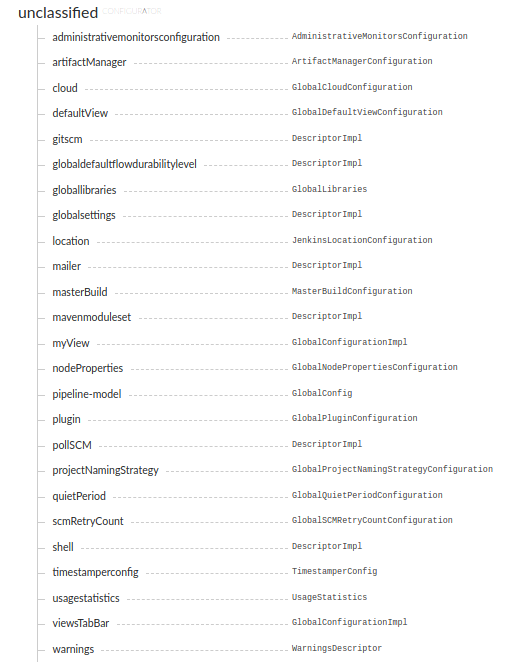Release notes of the latest release can be found here: https://wiki.jenkins.io/display/JENKINS/configuration+as+code+plugin
Setting up Jenkins is a complex process, as both Jenkins and its plugins require some tuning and configuration,
with dozens of parameters to set within the web UI manage section.
Experienced Jenkins users rely on groovy init scripts to customize jenkins and enforce desired state. Those scripts directly invoke Jenkins API and as such can do everything (at your own risk). But they also require you know Jenkins internals, and are confident in writing groovy scripts on top of Jenkins API.
Configuration-as-Code plugin has been designed as an opinionated way to configure jenkins based on human-readable declarative configuration files. Writing such a file should be feasible without being a Jenkins expert, just translating into code a configuration process one is used to executing in the web UI.
So, we are trying to replace this :
with this :
jenkins:
securityRealm:
ldap:
configurations:
- server: ldap.acme.com
rootDN: dc=acme,dc=fr
managerPasswordSecret: ${LDAP_PASSWORD}
cache:
size: 100
ttl: 10
userIdStrategy: CaseSensitive
groupIdStrategy: CaseSensitiveIn addition, we want such a file to have a well documented syntax, and tooling to assist in writing and testing, so end-users have full guidance in using this toolset and don't have to search stackoverflow for samples.
Have a look at this presentation for more details.
To get started you must have a running Jenkins instance with the plugin installed.
The only other requirement is that your Jenkins instance has an environment variable set that points to the current configuration location for configuration as code. So the plugin requires the environment variable CASC_JENKINS_CONFIG to be set. The variable can point to the following:
- Path to a folder containing a set of config files I.E
/var/jenkins_home/casc_configs - A full path to a single file I.E
/var/jenkins_home/casc_configs/jenkins.yaml - A URL pointing to a file served on the web I.E
https://mysite.com/jenkins.yaml
If everything was setup correctly you should now be able to browse the Configuration as Code management link in Manage Jenkins -> Configuration as Code.
Generally when you are about to configure your first instance you want to first browse the examples shown in the demos
section of this repository. If you've got a plugin, that we do not have an example for, you can consult the reference
help document by pressing the Documentation link on the Configuration as Code management link page. What you'll get a
web page like this:
If you've got a specific plugin you might wish to configure, search the page for the name of the plugin. The page will
show you which root element the configuration belongs to. Most plugins you install belong in the unclassifed root
element.
This configuration file includes root entries for various components of your jenkins master installation. the jenkins
one is for the root jenkins object, and other ones are for various global configuration elements.
jenkins:
securityRealm:
(...)
nodes:
slave:
name: "static-slave"
remoteFS: "/home/jenkins"
launcher: "jnlp"
slaveAgentPort: 50000
agentProtocols:
- "jnlp2"
tool:
git:
installations:
- name: git
home: /usr/local/bin/git
unclassified:
mailer:
adminAddress: admin@acme.org
replyToAddress: do-not-reply@acme.org
smtpHost: smtp.acme.org
smtpPort: 4441
credentials:
system:
domainCredentials:
credentials:
- certificate:
scope: SYSTEM
id: ssh_private_key
keyStoreSource:
fileOnMaster:
keyStoreFile: /docker/secret/id_rsaAlso see demos folder with various samples.
The configuration file format depends on the version of jenkins-core and installed plugins. Documentation is generated from a live instance, as well as a JSON-schema you can use to validate configuration file with your favourite yaml tools.
Configuration is not just about setting up jenkins master, it's also about creating an initial set of jobs. For this purpose, we delegate to the popular job-dsl-plugin and run a job-dsl script to create an initial set of jobs.
Typical usage is to rely on a multi-branch, or organization folder job type, so further jobs will be dynamically created. So a multi-branch seed job will prepare a master to be fully configured for CI/CD targeting a repository or organization.
Job-DSL plugin uses groovy syntax for it's job configuration DSL, so you'll have to mix yaml and groovy within your configuration-as-code file:
jenkins:
systemMessage: "Simple seed job example"
jobs:
- >
multibranchPipelineJob('configuration-as-code') {
branchSources {
git {
remote('https://github.com/jenkinsci/configuration-as-code-plugin.git')
}
}
}Currently you can provide initial secrets to Configuration-as-Code that all rely on <key,value>
substitution of strings in configuration. Just like in Jenkins: ${some_var}. We can provide these initial secrets in
the following ways:
- Using environment variables
- Using docker-secrets, where files on path
/run/secrets/${KEY}will be replaced by${KEY}in configuration - Using vault, see instructions in section below
Prerequisites
- The environment variable
CASC_VAULT_PWmust be present (Vault password) - The environment variable
CASC_VAULT_USERmust be present (Vault username) - The environment variable
CASC_VAULT_PATHmust be present (Vault key path, I.E /secrets/jenkins) - The environment variable
CASC_VAULT_URLmust be present (Vault url, including port)
If all those 4 are present, Configuration-as-Code will try to gather initial secrets from Vault. Requires read access for the configured user.
TODO provide a dockerfile to 'build' this documentation from specified jenkins-core release and plugins.
Here is a list of plugin we have successfully tested to support configuration-as-code approach :
- active directory plugin (details)
- artifactory plugin (details)
- credentials plugin (details)
- docker plugin (details)
- git plugin (details)
- ldap plugin (details)
- mailer plugin with some limitations (details)
- tfs plugin with some limitations (details)
- workflow-cps-global-lib aka "global libraries" (details)
- matrix-auth-plugin (details)
- role-strategy-plugin (details)
- warnings-plugin (>= 4.66) (details)
- kubernetes plugin (details)
- more to come soon...
As Configuration-as-code is demonstrated to be a highly requested topic in Jenkins community, we have published JEP 201 as proposal to make this a standard component of the Jenkins project.
Current status : proposal accepted.



